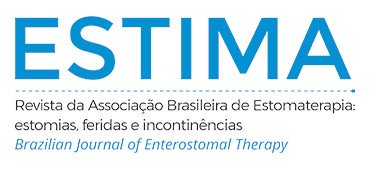THE SATISFACTION OF THE PERSON WITH URINARY RETENTION IN THE USE OF DIFFERENT TYPES OF URINARY CATHETERS
Abstract
Objective: to assess the satisfaction of the person with urinary retention in the face of the use of different types of urinary catheters, as well as to compare and analyze different attributes of these after their use in clean intermittent catheterization (CIC). Method: descriptive exploratory cross-sectional study, developed in a reference clinic in the state of São Paulo, from February to March 2020. The sample consisted of 32 adults registered in the service, and who adopted the CIC as a form of bladder emptying . Data collection was performed through individual interviews using a semi-structured questionnaire. Data were analyzed using descriptive, inferential statistics and categorization of responses to open questions. Results: of the 32 users, 84% were male, with a mean age of 54.16 years, 81% performed the procedure between 1 and 5 years, with a frequency of 4 to 6 times a day (66%). Most respondents (73%) preferred the hydrophilic-coated polyurethane catheter, converging with the percentage of users satisfied with the same catheter. Conclusion: the most satisfying technology is the hydrophiliccoated polyurethane catheter due to several attributes such as lubrication, firmness, packaging, urethral slip, handling, rapid urine clearance and comfort
Downloads
Metrics
References
Assis GM, Faro ACM. Autocateterismo vesical intermitente na lesão medular. Rev Esc Enferm USP. 2011;45(1):289–93. https://doi.org/10.1590/S0080-62342011000100041
Kennelly M, Thiruchelvam N, Averbeck MA, Konstatinidis C, Chartier-Kastler E, Trøjgaard P et al. Adult Neurogenic Lower Urinary Tract Dysfunction and Intermittent Catheterisation in a Community Setting: Risk Factors Model for Urinary Tract Infections. AdvUrol. 2019:1−13. https://doi.org/10.1155/2019/2757862
Rognoni C, Tarricone R. Intermittent catheterisation with hydrophilic and non-hydrophilic urinary catheters: systematic literature review and meta-analyses. BMC Urol. 2017;17:4. http://doi.org/10.1186/s12894-016-0191-1
Truzzi JC, Teich V, Pepe C. Cateteres com revestimento hidrofilico podem ser beneficos para o sistema público de saúde no Brasil? Uma análise de custo-efetividade em pacientes com lesão da medula espinhal. IBJU Int braz J urol. 2017;43. https://doi.org/10.1590/S1677-5538.IBJU.2017.0221
Assis GM, Fraga R. Cateterismo intermitente limpo: manual ilustrado de orientação ao usuário (adulto). Curitiba: Universidade Federal do Paraná − Hospital de Clínicas, 2015. Available at: https://quemcuida.com.br/blog/wp-content/uploads/2016/01/manual-cateterismo-vidas-secas.pdf
Lapides J, Diokno AC, Silber SJ, Lowe BS. Clean intermittent self-catheterization in the treatment of urinary tract disease. J Urol. 1972;107(3):45−61. https://doi.org/ 10.1016/s0022-5347(17)61055-3
Paula MAB, Thuler SR, Silveira NI, Azevedo GR. Intervenções nas Áreas de Abrangência da Estomaterapia. Lorena: CCTA, 2016. Available at: https://sobest.com.br/wp content/uploads/2020/10/PDF_INTERVENCOES.pdf
Schoeller SD, Martins MM, Ribeiro I, Lima DKS, Padilha MICS, Gomes B. Breve Panorama Mundial da Enfermagem de Reabilitação. RPER. 2018;1(1):6−12. https://doi.org/10.33194/rper.2018.v1.n1.01.4388
Fumincelli L, Mazzo A, Martins JCA, Henriques FMD, Orlandin L. Qualidade de vida de pacientes usuários do cateterismo urinário intermitente. Rev Latino-Am Enfermagem. 2017;25:e2906. https://doi.org/10.1590/1518-8345.1816.2906
Norager R, Bogebjerg C, Plate I, Lemaitre S. Apoiando melhor a adesão entre os pacientes envolvidos em autocateterismo intermitente. Br J Nurs. 2019;28(2):90–5.
Assis GM, Negri AF, Veiga SA, Galli CF, Moser ADL, Azevedo GR. Elaboração e Validação de um Instrumento de Avaliação da Percepção do Usuário na Utilização de Cateteres Vesicais. ESTIMA, Brazilian J Enteros Ther. 2016;13(2):62–9. Available at:https://www.revistaestima.com.br/estima/article/view/105
Assis GM, Negri AF, Tung SAV, Saccomani CFG, Moser ADL, Azevedo GR et al. Uso de cateteres vesicais para cateterismo intermitente limpo: satisfação da pessoa com lesão medular. Cogitare Enferm. 2015;20(4):813–20. Available at: http://revistas.ufpr.br/cogitare/article/view/41585
Pinder B, Lloyd AJ, Nafees B, Elkin EP, Marley J. Patient preferences and willingness to pay for innovations in intermittent selfcatheters. Patient Prefer Adherence. 2015;9:381–8. https://doi.org/10.2147/PPA.S73487
Feng D, Cheng L, Bai Y, Yang Y, Han P. Outcomes comparison of hydrophilic and non-hydrophilic catheters for patients with intermittent catheterization: An updated meta-analysis. Asian J Surg. 2020;43(5):633–5. https://doi.org/10.1016/j.asjsur.2019.12.009
DeFoor W, Reddy P, Reed M, VanderBrink B, Jackson E, Zhang B et al. Results of a prospective randomized control trial comparing hydrophilic to uncoated catheters in children with neurogenic bladder. J Pediatr Urol. 2017;13(4):373.e1-373.e5. https://doi.org/10.1016/j.jpurol.2017.06.003
Orlandin L, Nardi A, Costa RR de O, Mazzo A. Dificuldades de pacientes e cuidadores na realização do cateterismo intermitente limpo: revisão de escopo. ESTIMA, Brazilian J Enteros Ther. 2020;18:e1520. https://doi.org/10.30886/estima.v18.907_PT
Alencar VP. Cateterismo vesical intermitente limpo em crianças e adolescentes: análise da qualidade de vida do binômio cuidador-criança e dos fatores envolvidos. [tese]. São Paulo (SP): Faculdade de Medicina, Universidade de São Paulo; 2016. https://doi.org/10.11606/T.5.2016.tde-20092016-162358
Faleiros F, Pelosi G, Warschausky S, Tate D, Käppler C, Thomas E. Factors influencing the use of intermittent bladder catheterization by individuals with spina Bifida in Brazil and Germany. Rehabil Nurs. 2018;43(1):46–51. https://doi.org/10.1002/rnj.302
Cobussen-Boekhorst H, Hermeling E, Heesakkers J, Gaal B. Patients’ experience with intermittent catheterisation in everyday life. J Clin Nurs. 2016;25(9-10):1253–61. https://doi.org/10.1111/jocn.13146
Truzzi JC, Canalini AF, Prezotti JA, Resplande J. Recomendações Sociedade Brasileira de Urologia 2016: Cateterismo Vesical Intermitente.
Comissão Nacional de Incorporação de Tecnologias no SUS. Cateter hidrofílico para cateterismo vesical intermitente em indivíduos com lesão medular e bexiga neurogênica. 2019. Available at: http://conitec.gov.br/images/Consultas/Relatorios/2019/Sociedade/ReSoc140_SPEEDCATH__caterismo_vesical.pdf
Lei n. 8080 de 19 de Setembro de 1990 (BR). Dispõe sobre as condições para a promoção, proteção e recuperação da saúde, a organização e o funcionamento dos serviços correspondentes e dá outras providências. Diário Oficial da União [periódico na internet], Brasília (DF). 20 set 1990. Available at: https://legis.senado.leg.br/norma/549956
Downloads
Published
How to Cite
Issue
Section
License
Copyright (c) 2021 Andreia Bonello, Mirelle Cristina Faci, Marthyna Pereira de Mello

This work is licensed under a Creative Commons Attribution 4.0 International License.

























